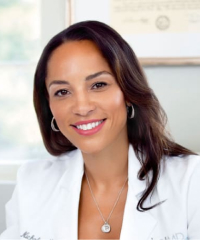5 Learnings: What I Wish I'd Known Before I Started My Business
These examples are intended to provide information and inspiration for your journey and are not a recommendation or endorsement.
Harvard-trained, board-certified dermatologist and cosmetic surgeon Kim Nichols, MD, FAAD, worked at her mentor’s practice for seven years on the Upper East side of Manhattan before opening her own practice in Greenwich, Connecticut in 2013. Since then, the staff has grown from 3 to 15, and Dr. Nichols recently opened a second location, in nearby Harbor Point. Here, she shares her experience on what she learned while creating her Medical Aesthetics practice.
1. Know what you want.
Knowing the role you want to play in the industry can help you get there. “Not every healthcare professional or injector wants to own their own business and that’s okay,” Dr. Nichols says. But if your goal is to open your own practice, having the drive is key. “That entrepreneurial spirit, that hustle, is essential because that may help you create a sustainable practice and help you surround yourself with staff that also believe in that,” she says.
That entrepreneurial spirit, that hustle, is essential because that may help you create a sustainable practice and help you surround yourself with staff that also believe in that.
2. Where Do You Want to Practice?
Dr. Nichols, through the lens of an experienced practice owner, suggests exploring different types of work environments, whether it’s a small, local practice or a franchise with multiple locations to find out where you want to practice. When she was looking to open a small boutique practice, she needed to know her local market. “People want to come to you obviously because of your credentials and your results, but they also want to know that you're in tune with what they like,” she explains, and that can vary by region. She noted that larger franchise practice owners may need to be open to a wider variety of aesthetic tastes. The type of practice you want will also dictate how you structure your business plan. “It’s a question you need to keep asking yourself—what you want and where you see the practice going,” Dr. Nichols says.
3. Research your state’s rules and regulations.
Before you go into practice, whether your own or someone else's, go to the state board and find out their requirements. For example, Dr. Nichols shared that aesthetician requirements in Connecticut differ from requirements in New York. She also shared that in her experience, it's important to research what's required for each role and to understand your state requirements for licensing. In Dr. Nichols’ experience, she noted that it may be helpful to learn exactly which procedures you can perform in-office, who can perform them, and the qualifications you and any potential staff will need.
4. Learn about key positions within a practice.
A practice generally has a variety of roles that comprise a team. For example, when Dr. Nichols first opened with a staff of three—herself, a medical assistant, and a medical aesthetician, she was seeing patients, answering phones, and managing the business. Hiring an office operations manager freed her up to focus on other high level parts of the business and to focus on the care of patients. “Our operations manager brings it all together—without her, it wouldn’t work,” she says. Some aesthetics practices might also have patient care coordinators. In Dr. Nichols’ office, that role is filled by medical assistants and physician assistants, who use their knowledge about the procedures as well as the timelines involved to go over treatment plans with clients. And because it’s a small, localized operation, everyone in the office knows how to answer the phone. Dr. Nichols highlighted that it’s important to make sure everyone in the office has a baseline understanding of aesthetics and can appropriately respond to the patient or defer to someone who has an informed answer.
5. Put patient satisfaction first.
Dr. Nichols shares that for her, patient satisfaction is rooted in feedback. She advises to have strong patient communication by calling and emailing patients the day after procedures to check on how they’re doing. To understand patient satisfaction, she constantly surveys new patients about their experience with the practice, and considers the feedback carefully. “On the rare occasion that a patient gives us a 4 out of 5, my office will personally call to learn what we can do to make it a 5.” Dr. Nichols recommends researching books or literature on customer service when developing standards for practice customer service, “I highly recommend anyone looking to become a practice owner to make [patient satisfaction] their goal.”

CREDIT
About Dr. Kim Nichols
Kim Nichols, MD, FAAD is a Harvard-trained, board-certified, celebrity dermatologist that treats for both medical and cosmetic skin care concerns.

